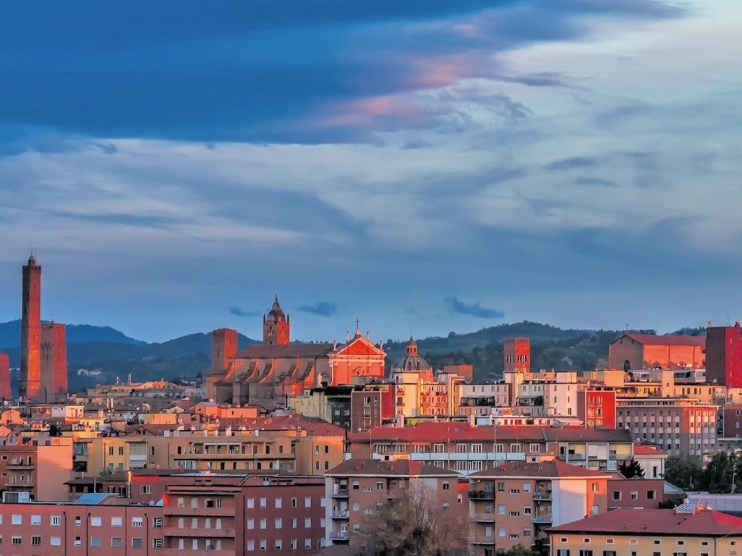
Travel is inevitably a multi-sensory experience, but some destinations make their mark more on one sense than others. In my mind, Marrakech will always be synonymous with the sound of the call to prayer reverberating across the rooftops at sunset. Abu Dhabi is the searing heat of the sun on my skin, and my overriding memory from Istanbul’s Grand Bazaar is the fragrance of spices and rose petals mingling.
Taste, though, seems to be a more complex sensation. There are flavours that immediately take me back to a time, to a place – gelato in Amalfi and warm, soft non in Tashkent’s Chorsu Bazaar amongst them – but more often than not, another bite of something last tasted long ago triggers a cascade of other thoughts, reminding me of all the sights, sounds, and smells which were around me. It’s probably the closest I will ever get to time travel.
I decided to eat my way across Bologna after a tip-off from Edible Reading, whose culinary adventures occasionally take them well beyond the M4 corridor. They described Bologna as “the city where I ran out of superlatives”, and having drooled rather more than I should have done over his descriptions of porchetta panino studded with caperberries, aged culatello, and even “unreally-pink mystery meat”, I vowed to make my own pilgrimage to what is increasingly recognised as the culinary capital of Italy.
A place of culinary excellence
An avowed Italophile, I don’t know why it took me so long to visit the city which not only gave its name to spaghetti bolognese, but is also the homeland of Parmigiano Reggiano, balsamic vinegar, mortadella, and prosciutto di Modena, not to mention some excellent wines.
I discussed this over lunch at Da Cesari with Vittoria Donini of Bologna Welcome, simultaneously devouring a plateful of rabbit ragout, and her honest assessment caught me by surprise. Historically, Bologna and the surrounding Emilia Romagna region never sold itself as a tourist destination. The local economy was driven by agriculture and industry – the manufacture of luxury cars in particular – so there was no need to court tourists as well. It is only in recent years that Bologna has begun marketing itself alongside the likes of Florence, Verona, and Venice, promoting its UNESCO-listed porticoes, the oldest continually operating university in the world, and the iconic Due Torri (a pair of leaning towers) in addition to its culinary delights.
Orientation tours are usually the best introduction to a city, and to get to grips with Bologna’s food scene it makes sense to start at FICO Eataly, a vast farm x exhibition space x factory located a free shuttle bus ride from the city centre. Educational as well as entertaining, it’s easy to spend an entire day here watching demonstrations, wandering in the vineyards and olive groves, riding on the patisserie-themed carousel, and passing through the fettuccine curtain to enter a many times larger than life wheel of parmesan cheese. There are guided tours in English as well as Italian, and the €29 package price includes entry to FICO, the tour, and five different tastings. This theme park of food is the #1 tourist attraction in Emilia Romagna and it is easy to see why: they have taken the region’s best ingredients and recipes and presented them in such a way that they are engaging for everyone.
What FICO cannot compete with, though, is the atmosphere of Bologna’s historic streets, their famed porticoes stretching out above the cobbles and offering shelter from rain and sun alike. The season for outdoor dining is long: I visited in early November and the evenings were still mild enough for bars and restaurants to throw open their doors, their patrons tumbling out onto the pavement to chat, smoke, or bag the table with the best people-watching potential. This is a lifesaver for the likes of Sette Tavoli, a tiny place with just seven tables inside and the kind of ambience where I had no qualms about dining alone.
I was shown to a table beside the bar – close enough never to run out of wine – and left myself in the capable hands of chef chef Vincenzo e Mauro and his team. One dish stood out, and if I ever have the fortune to taste anything similar it will transport me right back to that night. Homemade with buffalo ricotta and pig’s cheek bacon, it might well be the world’s best tortellone, unfussy in its presentation but showcasing the very best of Emilia Romagna’s ingredients.
Bologna’s bolognese
The menu at Sette Tavoli is defined by its simplicity and the kind of home cooking I imagine a Bolognese grandma would make. In a fit of indulgence about which I have no regrets, though, I dined the following night at Scaccomatto Trattoria. Here chef Mario Ferrara uses many of the same local ingredients but serves them in a more elaborate fashion.
Indecisive and weak-willed as I am, there could only really be one option: the eight-course tasting menu, an unbeatable way to try as many different dishes as possible. There were marinated anchovies lying firm upon a bed of sweet peppers, great curls of caramelised onion scattered with toasted hazelnuts, thumbnail-sized tortellini in a lemongrass and parmesan cream, and a desert which must be a distant cousin of a creme caramel, but with a lightness of texture and flavour that will no doubt stalk my dreams for years to come.
Several hours passed whilst I was eating and the diners on tables around me changed, but it felt as if I were in a bubble, so entranced was I by the flavours on my palate that all my other senses became muted.
I couldn’t tell you anything about the artworks on the walls or the conversation we had that night; all my recollections are about the food. For me at least, Bologna will always be about that meal, and I’m counting down the days until I can eat at Scaccomatto again.